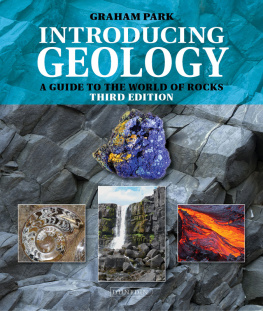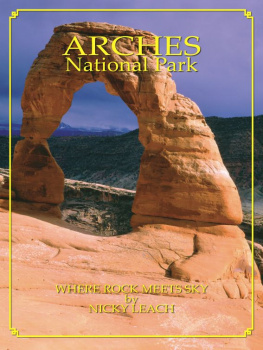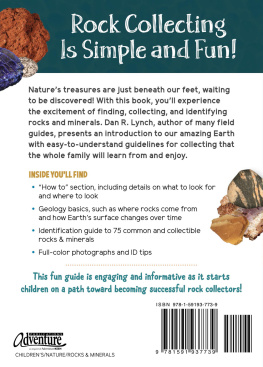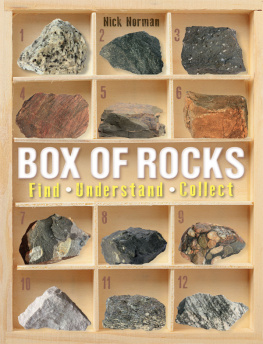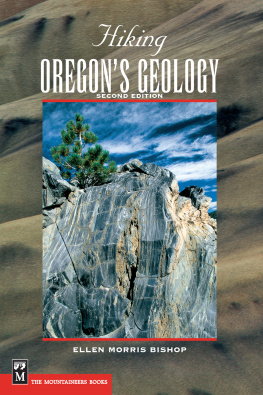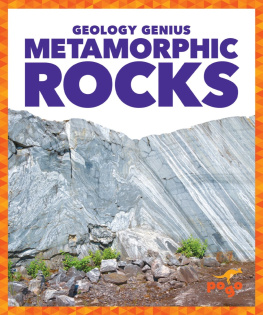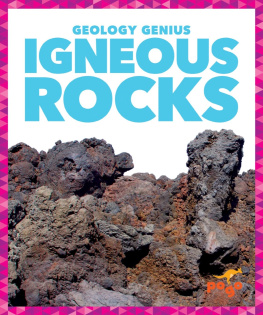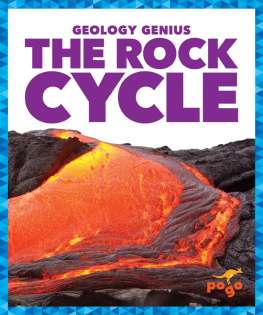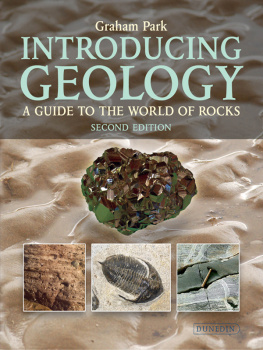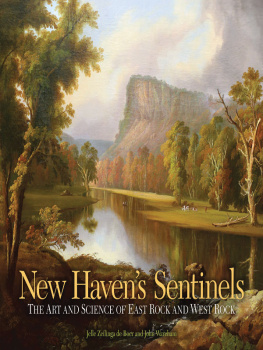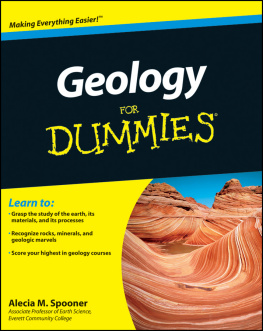Other Titles in this Series:
Introducing Astronomy
Introducing Geomorphology
Introducing Meteorology ~ A Guide to the Weather
Introducing Metamorphism
Introducing Mineralogy
Introducing Natural Resources
Introducing Oceanography
Introducing Palaeontology ~ A Guide to Ancient Life
Introducing Sedimentology
Introducing Stratigraphy
Introducing Tectonics, Rock Structures and Mountain Belts
Introducing the Planets and their Moons
Introducing Volcanology ~ A Guide to Hot Rocks
For further details of these and other Dunedin
Earth and Environmental Sciences titles see
www.dunedinacademicpress.co.uk
Introducing
Geology
A Guide to the World of Rocks
THIRD EDITION
Graham Park
First edition published in 2006
Second Edition 2010
Third edition 2019 by
Dunedin Academic Press Ltd
This ebook edition published 2019
Head Office:
Hudson House
8 Albany Street
Edinburgh EH1 3QB
ISBNs:
Print edition (paperback): 9781780460758
Epub edition: 9781780465968
Copyright 2019 Graham Park
The right of Graham Park to be identified as the author of this work has been asserted by him in accordance with sections 77 & 78 the Copyright, Designs and Patents Act 1988.
A catalogue record for this book is available from the British Library.
All rights reserved by the publisher under International Copyright Conventions. By payment of the necessary fees you have been granted a non-exclusive, non-transferable licence to access and read the text of this e-book on-screen. No part of this text may be reproduced, transmitted, down-loaded, decompiled, re-engineered or stored in any information retrieval system in any form or by any means except in accordance with the terms of the licence granted to you. If in doubt as to what use may be permitted by the non-exclusive licence that you have purchased, please contact the publisher, Dunedin Academic Press Ltd.
www.dunedinacademicpress.co.uk
Contents
Acknowledgements
I am indebted to Mrs Anne Shelley of the Orcadian Stone Company, Golspie, Sutherland, for allowing me to photograph some of the excellent specimens of fossils and minerals in her geological museum. My thanks are also due to Anne Morton of Dunedin Academic Press and an anonymous reviewer of the draft of the first edition for their numerous helpful suggestions, and to Professor Charles Holland of Trinity College, Dublin for his careful review of .
The second edition has benefited from a number of helpful suggestions for improvement from various reviewers of the first edition. I am grateful in particular to John Winchester, who pointed out a number of mistakes and drew my attention to the revised geological timescale. Any remaining inadequacies in this book are entirely the authors responsibility.
Finally I wish to thank my wife Sylvia for her constant support and encouragement, and as a non-geologist, for test driving the first draft.
The following sources of data were particularly useful.
Duff, P. McL. D., Holmes Principles of Physical Geology , 4th edition, Chapman & Hall, London, 1993.
Gradstein, F. M., Ogg, J. G. & Smith, A. G., A Geologic Time Scale , Cambridge University Press, 2005.
Keary, P. (ed.), The Encyclopedia of the Solid Earth Sciences , Blackwell, Oxford, 1993.
Lambert, D., The Cambridge Field Guide to Prehistoric Life , Cambridge University Press, 1985.
Stanley, S. M., Exploring Earth and Life through Time , Freeman, New York, 1993.
Note to the third edition
I have taken the opportunity to thoroughly revise the text and improve many of the line drawings, with greater use of colour, taking into account the many helpful suggestions made by reviewers. Some of the photographs have been exchanged for better versions, and a number of others added. Graham Park, July 2018 .
List of tables and illustrations
Sourced illustrations
The following illustrations are reproduced by permission: British Geological Survey. NERC. All rights reserved. IPR/73-34C, 122-06CT: .
The following illustrations have been adapted from published sources:
: Hamblin, W.K. 1989. The Earths dynamic systems , 5th edition. Macmillan, New York.
: Bott, M.P. 1982. The interior of the Earth , 2nd edition, Edward Arnold, London.
: Hamblin, W.K. 1989. The Earths dynamic systems , 5th edition. Macmillan, New York.
: McElhinny, N.W. 1973. Palaeomagnetism and plate tectonics , Cambridge University Press.
: Wyllie, P.J. 1976. The way the Earth works . Wiley, New York.
(volcanoes) via Wikimedia commons.
: Vine, F.J. and Hess, H.H. 1970. In: The Sea , v4. Wiley, New York.
plate via Wikimedia Commons.
: Saemundsson, K. 1974. Evolution of the axial rifting zone in northern Iceland. Bulletin of the Geological Society of America , , 495504.
: Elliott, D. and Johnstone, M.R.W. 1980. Structural evolution in the northern part of the Moine thrust zone. Transactions of the Royal Society of Edinburgh: Earth Sciences , 71, 6996.
: Lister, G.S. & Davis, G.A. 1989. The origin of metamorphic core complexes. Journal of Structural Geology , 11, 6594.
: Ramsay, J.G. 1980. Shear geometry: a review. Journal of Structural Geology , 2, 8399.
: Buchan, K.L., Mertanen, S., Park, R.G., Pesonen, L.J., Elming, S.A., Abrahamsen, A. & Bylund, G. 2000. Comparing the drift of Laurentia and Baltica in the Proterozoic: the importance of key palaeomagnetic poles. Tectonophysics , , 16798.
: Dalziel, I.W.D. 1997. Neoproterozoic-Palaeozoic geography and tectonics: review, hypothesis, environmental speculation. Geological Society of America Bulletin , , 1, 1642.
: Matte, P. 1986. Tectonics and plate tectonics model for the Variscan belt of Europe. Tectonophysics , , 32974.
: Torsvik, T.H. and Cox, L.R.M. 2017. Earth history and palaeogeography . Cambridge University Press.
Preface: A world of rock
Our world is made of rock. This fact might be difficult to comprehend at first, since much of the Earths surface is covered by vegetation, concrete or water, but if one digs down far enough, solid rock will always be found. Those fortunate to live in a landscape where rock outcrops are obvious features will maybe have wondered what kinds of rock they are looking at and how they have come to be where they are. The answers to these questions are in the province of the geologist, and this book is an attempt to explain what geology can tell us about the world we live in. Many objects of great beauty, or which excite our curiosity such as crystals or fossils are to be found by examining rocks, and those searching for and finding such objects gain much more by knowing how they originated. Fossils, for example, are interesting in themselves of course, but set in the context of geological time, provide us with the evidence for biological evolution and the clues that give us an insight into the origins of life itself.
The science of geology covers many different subjects, and embraces the methods of physicists, chemists and biologists in order to understand the rocks that make up the Earth and the processes that formed and modified them. Broadly speaking, geological phenomena can be divided into materials and processes. Materials include rocks, and those objects that are contained within rocks, such as minerals and fossils. One set of processes is responsible for shaping the landscape; these wear down rocks to form gravel, sand and mud that eventually end up as sedimentary deposits in rivers, lakes and the sea. Rocks formed in this way are termed sedimentary rocks . Another type of process involves molten rock, which forms deep within the Earth and makes its way towards the surface to form volcanoes. On its way up, molten rock ( magma ) is injected into the surrounding solid rock, forming a variety of structures. Rocks formed by the solidification of magma are termed igneous rocks . A third group, known as tectonic processes, results from large-scale movements of the Earths crust ( plate tectonics ) which in turn lead on a smaller scale to the formation of faults and to the squeezing and stretching of solid rocks into new shapes. Tectonic processes taking place at great depth are accompanied by changes in the rocks themselves brought about by the greater heat and higher pressure; rocks, of whatever origin, changed in this way in the solid state are termed metamorphic rocks .

